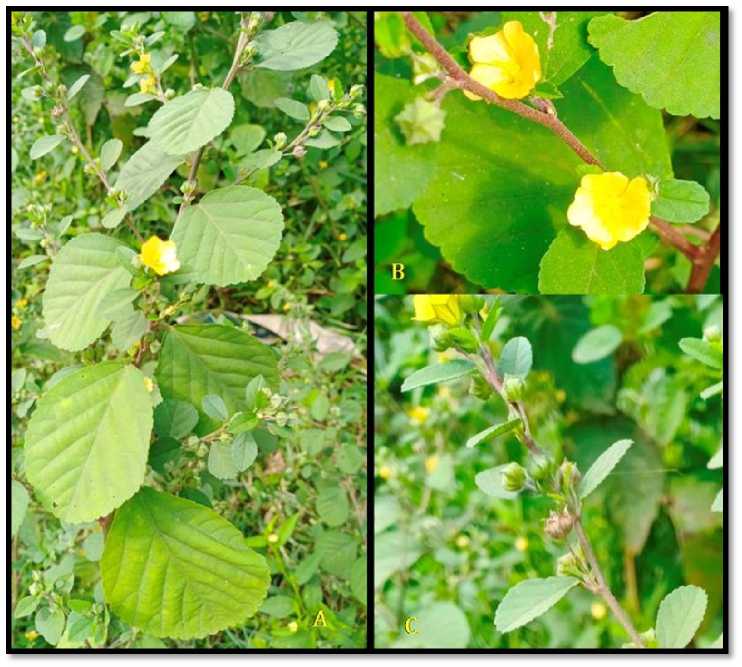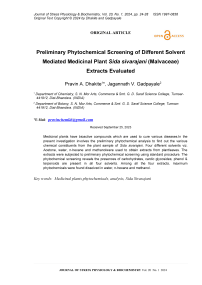Preliminary phytochemical screening of different solvent mediated medicinal plant Sida sivarajani (Malvaceae) extracts evaluated
Автор: Dhakite P.A., Gadpayale Ja.V.
Журнал: Журнал стресс-физиологии и биохимии @jspb
Статья в выпуске: 1 т.20, 2024 года.
Бесплатный доступ
Medicinal plants have bioactive compounds which are used to cure various diseases.In the present investigation involves the preliminary phytochemical analysis to find out the various chemical constituents from the plant sample of Sida sivarajani . Four different solvents viz. Acetone, water, n-hexane and methanolwere used to obtain extracts from plantleaves. The extracts were subjected to preliminary phytochemical screening using standard procedure. The phytochemical screening reveals the presences of carbohydrates, cardic glycosides; phenol & terpenoids are present in all four solvents. Among all the four extracts, maximum phytochemicals were found dissolved in water, n-hexane and methanol.
Medicinal plants, phytochemicals, analysis, sida sivarajani
Короткий адрес: https://sciup.org/143182394
IDR: 143182394
Текст научной статьи Preliminary phytochemical screening of different solvent mediated medicinal plant Sida sivarajani (Malvaceae) extracts evaluated
Phyto constituents are the natural bioactive compounds found inplants. This phyto constituent’s work with nutrients and fibers toform an integrated part of defense system against various diseasesand stress conditions. Phyto chemicals (Handral et al. , 2012) are basically divided intotwo groups, i.e. primary and secondary constituents; according totheir functions in plant metabolism. Primary constituents comprise common sugars, amino acid, proteins and chlorophyll while secondary constituents consist of alkaloids, terpenoid, steroids andflavonoids, so on.
Plants are nature's "Chemical factories" providing the richest source of organic chemicals on earth. The world is blessedwith a great variety of natural vegetations, some of which are used as traditional medicineto cure various sicknesses and diseases. But, considering richnessof the plant world, the knowledge of plants acquired by man is still insufficient. World Health Organization (Ujowundu et al. , 2010) describes a medicinal plant as any plant in which one or more of its organs contains substances thatcan be used for therapeutic purposes or which are precursors for the synthesis of useful drugs. Many of our official drugs have come through the research work of the botanists, chemists and ethnobotanists. Since botanists specialize in gathering knowledge of plants. Consequently they form a bridge between the natives and plants, eventually utilization ofplants are possible when a chemist acts as a bridge between the botanists and the users.
Morphology of Sidasivarajanii (Tambde et al. , 2020)
Erect, branched, undershrub, 1 m tall. Stem terete, green, minutely pubescent with small stellate hairs. Leaf blades on younger shoot much larger, concolorous, obovate or suborbicular, truncate or rounded at base, margins serrate to create, entire towards base, sub-obtuse or acute at apex; those on flowering shoots smaller, rhomboid to lanceolate, 3-nerved from base, lateral nerves 3–6 pairs, nerves raised on the lower surface, densely stellate-tomentose beneath, sparsely pubescent above, petiolate, stipulate. Flowers axillary, solitary; pedicelate. Calyx 3–6 mm across, campanulate, 5–lobed; the lobes, ovate, acuminate at apex, tomentose with minute stellate hairs. Corolla orangeyellow; petalsobovate, retuse or emarginate at apex, minutely stellate hairy at base. Staminal column 2–2.5 mm long, stellate pubescent; antheriferous at apex, filaments 1–2 mm long, anthers reiform, pale-yellow. Ovary 1–1.5 mm diameter, conical, stellate hairy; styles 5, covered by minute stellate hairs, stigma capitate, yellow. Schizocarps 2–3 mm long, ovoid-ellipsoid, raised at centre, green when immature, light brown at maturity, grooved between mericarps; mericarps 5, 3–4 × 1.5–2 mm, completely included in the calyx, completely covered densely with long stellate and sparsely with simple hairs; awns 1–1.5 mm long, covered with stellate hairs. Seed one per mericarps, brownish to black, laterally compressed, glabrous at the hilum (Figure 1).
Phenology : Flowering from September to February; fruiting from October to March.
MATERIALS AND METHODS
Plant Collection and Identification
The plant species of were collected from Tumsar regions of Bhandara District, Maharashtra, India during the months of August, September and October in the year 2019.
Processing of plant samples
The plants leaves of Sidasivarajanii(Malvaceae) of was taken from Tumsar regions of Bhandara District , crushed to powder form, and then taken in thesoxhlet apparatus for hot extraction with organic solvents such asAcetone, water, n-hexane and methanol.
Preparation of Extract
The Sida sivarajanii (Malvaceae) leaves were separated and cleaned well. Cleaned leaves were then dried under shade. The drying was done until all the water molecules evaporated and leaves became well-dried for grinding. After drying, the leaves were ground well using mechanical blender into fine powder and transferred into air-tight container with proper labelling for further use. The dried and powdered leaves were extracted sequentially with acetone, water, n-hexane and methanol using Soxhlet apparatus. The plant specimen leaves powder was weighed (20 g) and successively extracted with 200 ml of solvents like
methanol (60°- 80° C), acetone, n-hexane and aqueous by soxhelation for a period of 24 hours.
Qualitative Phytochemicals Screening
The extract was tested for the presence of bioactive compounds by using standard methods (Sofowra, 1993; Trease, Evans, 1989; Harborne, 1973)
The methanol, acetone, n-hexane and aqueous leaves extracts were screened for different phytochemicals constituents’ viz., glycosides (Aiyegroro, Okoh, 2010; Silva et al., 2017), carbohydrate (Raaman, 2006; Singh, Kumar, 2017), reducing sugars (Raaman, 2006; Singh, Kumar, 2017), protein Raaman, 2006), flavonoids (Singh, Kumar, 2017; Gul et al., 2017), saponins (Raaman, 2006; Tiwari et al., 2011; Rauf et al., 2013) alkaloids (Silva et al., 2017; Raaman, 2006, Auwal et al., 2014; Singh, Kumar, 2017), tannins (Tiwari et al., 2011; Pandey, Tripathi, 2014), phenol (Raaman, 2006; Tiwari et al., 2011), terpenoids (Gul et al., 2017), Gum Nanna et al., 2013), and resins (Singh, Kumar, 2017;
Kumar et al. , 2013).
RESULTS AND DISCUSSION

Figure 1. Photo plate of Sida sivarajanii Tambde, Sardesai & A.K. Pandey
Table 1 : Qualitative Phytochemicals Analysis of leaves of Sida Sivarajani L. f. extracts
|
S. No |
Phytochemicals constituents |
Water |
n-hexane |
Methanol |
Acetone |
|
1 |
Saponins |
+ |
- |
- |
+ |
|
2 |
Alkaloids |
+ |
+ |
+ |
+ |
|
3 |
Tannins |
+ |
+ |
+ |
- |
|
4 |
Flavonoids |
+ |
+ |
+ |
- |
|
5 |
Terpenoids |
+ |
+ |
+ |
- |
|
6 |
CardicGlycosides |
+ |
+ |
- |
- |
|
7 |
Anthraquione |
+ |
+ |
+ |
+ |
|
8 |
Coumarin Glycosides |
- |
- |
+ |
- |
|
9 |
Protein &Amino acids |
- |
- |
- |
- |
|
10 |
Carbohydrate &Reducing Sugars |
- |
- |
- |
- |
|
11 |
Fixed oil & fats |
+ |
- |
- |
+ |
|
12 |
Gum &Mucilages |
- |
+ |
- |
+ |
|
13 |
Resins |
+ |
+ |
- |
+ |
‘+’ represents the presence of compounds; ‘-’represents the absence of compounds
CONCLUSION
The present study was carried out to determine the qualitative phytochemicals constituents present in the extracts of Sida Sivarajani . The result reveals that the aqueous extract of plant material showed maximum phytochemicals constituents. The same extract could be utilized for the isolation of further bioactive metabolites. The study also provides a strong evidence for the use of extract to treat various pharmacological activities. It was concluded that the plant is rich in phytochemicals with significant medicinal applications.
CONFLICTS OF INTEREST
The authors declare that they have no potential conflicts of interest.
Список литературы Preliminary phytochemical screening of different solvent mediated medicinal plant Sida sivarajani (Malvaceae) extracts evaluated
- Aiyegroro, O.A., Okoh, A.I. (2010). Preliminary phytochemical screening and in vitro antioxidant activities of aqueous extract of Helichrysum longifolium DC. BMC Compl. And Alt. Med., 10, 21.
- Auwal MS, Saka S, Mairiga IA, Sanda KA, Shuaibu A and Ibrahim A (2014). Preliminary Phytochemical and elemental analysis of aqueous and fractionated pod extracts of Acacia nilotica (Thorn mimosa). Veterinary Research Forum; 5(2), 95-100.
- Gul R, Jan SU, Syed F, Sherani F, Nusrat Jahan (2017).
- Preliminary Phytochemicals Screening, Quantitative Analysis of Alkaloids, and Antioxidant Activity of Crude Plant Extracts from Ephedra intermedia Indigenous to Balochistan. The Scientific World Journal, Article ID 5873648
- Handral H.K., Pandith A., Shruthi S.D. (2012) A review on Murraya koenigii: Multipotential medicinal plant. Asian J. Pharm. Clin. Res., 5, 5-14.
- Harborne, J.B. (1973). Phytochemicals Methods. Chapman and Hall Ltd., London, 49-188.
- Kumar RS, Venkateshwar C, Samuel G, Rao SG (2013). Phytochemical Screening of some compounds from plant leaf extracts of Holoptelea integrifolia (Planch.) and Celestruse marginata (Grah.) used by Gondu tribes at Adilabad District, Andhrapradesh, India. International Journal of Engineering Science Invention. 2(8), 65- 70.
- Nanna RS, Banala M, Pamulaparthi A, Kurra A, Kagithoju S (2013). Evaluation of Phytochemicals and Fluorescent Analysis of Seed and Leaf Extracts of Cajanus cajan L. International Journal of Pharmaceutical Sciences Review and Research.; 22(1), 11-18.
- Pandey A and Tripathi S (2014). Concept of standardization, extraction and pre phytochemical screening strategies for herbal drug. Journal of significant medicinal applications. Pharmacognosy and Phytochemistry; 2(5), 115119.
- Raaman N. Phytochemical Techniques (2006), New India Publishing Agency, New Delhi, 19-24.
- Rauf, A., Jan, M., Rehman, W., & Muhammad, N. (2013). Phytochemical, phytotoxic and antioxidant profile of Caralluma tuberculata NE Brown. Wudpecker Journal of Pharmacy and Pharmacology, 2(2), 21-25.
- Silva GO, Abeysundara AT, Aponso MM (2017), Extraction methods, qualitative and quantitative techniques for screening of phytochemicals from plants. American Journal of Essential Oils and Natural Products.; 5(2), 29-32
- Singh V, Kumar R. (2017). Study of Phytochemical Analysis and Antioxidant Activity of Allium sativum of Bundelkhand Region. International Journal of Life Sciences Scientific Research.; 3(6),1451-1458.
- Sofowra, A. (1993) Medicinal Plants And traditional Medicine In Africa. Spectrum Books Ltd., Ibadan, Nigeria, 191-289.
- Tambde G., Sardesai M.& Pandey A.K. (2020) Sida sivarajanii (Malvaceae): a new species from India, Phytotaxa, 428 (2), 104-112.
- Tiwari P, Kumar B, Kaur M, Kaur G, Kaur H (2011). Phytochemicals screening and Extraction: A Review. Internationale Pharmaceutica Sciencia.; 1(1), 98- 106.
- Trease, G.E., Evans, W.C. (1989). Pharmacognosy, Bailliere Tindall, London, 11, 45-50.
- Ujowundu C.O., Okafor O.E., Agha N.C., Nwaogu L.A., Igwe K.O., Igwe C.U. (2010) Phytochemical and chemical composition of Combretum zenkeri leaves. J. Med. Plants Res., 4, 965-968.


